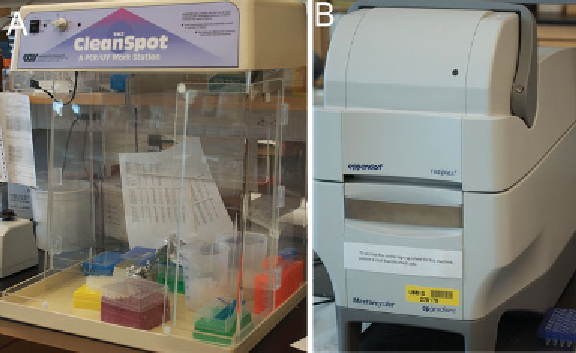Biology Reference
In-Depth Information
Fig. 2. Working station (
a
) and 96-well thermal cycler for PCR (
b
) .
3.8.1. Sample Preparation
1. For in vivo studies, rats are sacrifi ced in deep anesthesia after
intracerebral infusion of 100 mL autologous blood into the
right basal ganglia. Following quick removal of brains, ipsi-
and contralateral basal ganglia are sampled and frozen in liquid
nitrogen. For in vitro cell culture experiments, the cell medium
is removed and plates are washed three times with chilled PBS.
Then the cells are quickly scraped and collected by centrifuga-
tion at 4°C and stored at −80°C.
2. Total RNA is extracted from the frozen tissue and cultured
cells with Trizol reagent (Gibco BRL, Grand Island, NY, USA)
in accordance with the manufacturer's recommendations.
Make aliquots of RNA and store at −80°C.
3. 1 mg RNA is digested with deoxyribonuclease I (DNase I,
amplifi cation grade; Gibco BRL Grand Island, NY, USA).
3.8.2. Prepare RNA
for Reverse Transcription
4. Complementary DNA is synthesized by reverse transcription
mixing 1 mg of DNase I-digested RNA (11 mL) with 14 mL
reaction buffer (Perkin Elmer, Foster City, CA, USA) contain-
ing dNTP (dATP, dCTP, dGTP, and dTTP), 25 mmol/L
MgCl
2
, 10× polymerase chain reaction buffer II, Random
Hexamer Primer, RNase inhibitor, and murine leukemia virus
(MuL V) reverse transcriptase.
5. The reaction is performed at 42°C for 30 min and terminated
at 99°C after 5 min.
6. Diethyl pyrocarbonate water (75 mL) is added to dilute the com-
plementary DNA to 100 mL and stored at −20°C for later use.
3.8.3. Generate First-
Stranded cDNA

Search WWH ::

Custom Search